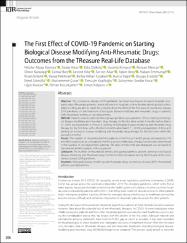| dc.contributor.author | Kanıtez, Nilüfer Alpay | |
| dc.contributor.author | Kiraz, Sedat | |
| dc.contributor.author | Dalkılıç, Ediz | |
| dc.contributor.author | Kimyon, Gezmiş | |
| dc.contributor.author | Mercan, Rıdvan | |
| dc.contributor.author | Karadağ, Ömer | |
| dc.contributor.author | Beş, Cemal | |
| dc.contributor.author | Mercan, Rıdvan | |
| dc.date.accessioned | 2023-05-06T17:23:32Z | |
| dc.date.available | 2023-05-06T17:23:32Z | |
| dc.date.issued | 2022 | |
| dc.identifier.issn | 2147-9720 | |
| dc.identifier.issn | 2148-4279 | |
| dc.identifier.uri | https://doi.org/10.5152/eurjrheum.2022.21153 | |
| dc.identifier.uri | https://hdl.handle.net/20.500.11776/12129 | |
| dc.description.abstract | Objective: The coronavirus disease 2019 pandemic has been resulting in increased hospital occupancy rates. Rheumatic patients cannot still reach to hospitals, or they hesitate about going to a hospital even they are able to reach. We aimed to show the effect of the first wave of coronavirus disease 2019 pandemic on the treatment of biological disease-modifying anti-rheumatic drugs in patients with rheumatoid arthritis or spondyloarthritis. Methods: Patients were divided into three groups as follows: pre-pandemic (Pre-p: starting on biological disease-modifying anti-rheumatic drug therapy for the first time within 6 months before March 11, 2020); post-pandemic A (Post-p A: starting on biological disease-modifying anti-rheumatic drug therapy for the first time within the first 6 months after March 11, 2020); post-pandemic B (Post-p B: starting on biological disease-modifying anti-rheumatic drug therapy for the first time within the second 6 months). Results: The number of rheumatoid arthritis patients in the Post-p A and B groups decreased by 51% and 48%, respectively, as compared to the Pre-p group similar rates of reduction were also determined in the number of spondyloarthritis patients. The rates of tofacitinib and abatacept use increased in rheumatoid arthritis patients in Post-p period. Conclusion: The number of rheumatoid arthritis and spondyloarthritis patients starting on biological disease-modifying anti-rheumatic drugs for the first time decreased during the first year of the coronavirus disease 2019 pandemic. | en_US |
| dc.language.iso | eng | en_US |
| dc.publisher | Aves | en_US |
| dc.identifier.doi | 10.5152/eurjrheum.2022.21153 | |
| dc.rights | info:eu-repo/semantics/openAccess | en_US |
| dc.subject | Biological disease-modifying anti-rheumatic drug | en_US |
| dc.subject | coronavirus disease 2019 | en_US |
| dc.subject | rheumatoid arthritis | en_US |
| dc.subject | spondyloarthritis | en_US |
| dc.subject | Society Classification Criteria | en_US |
| dc.subject | Bath Ankylosing-Spondylitis | en_US |
| dc.subject | Spondyloarthritis | en_US |
| dc.subject | Reliability | en_US |
| dc.title | The First Effect of COVID-19 Pandemic on Starting Biological Disease Modifying Anti-Rheumatic Drugs: Outcomes from the TReasure Real-Life Database | en_US |
| dc.type | article | en_US |
| dc.relation.ispartof | European Journal Of Rheumatology | en_US |
| dc.department | Fakülteler, Tıp Fakültesi, Dahili Tıp Bilimleri Bölümü, İç Hastalıkları Ana Bilim Dalı | en_US |
| dc.identifier.volume | 9 | en_US |
| dc.identifier.issue | 4 | en_US |
| dc.identifier.startpage | 206 | en_US |
| dc.identifier.endpage | 211 | en_US |
| dc.institutionauthor | Mercan, Rıdvan | |
| dc.relation.publicationcategory | Makale - Uluslararası Hakemli Dergi - Kurum Öğretim Elemanı | en_US |
| dc.identifier.wos | WOS:000926134500004 | en_US |
| dc.identifier.pmid | 36650959 | en_US |



















